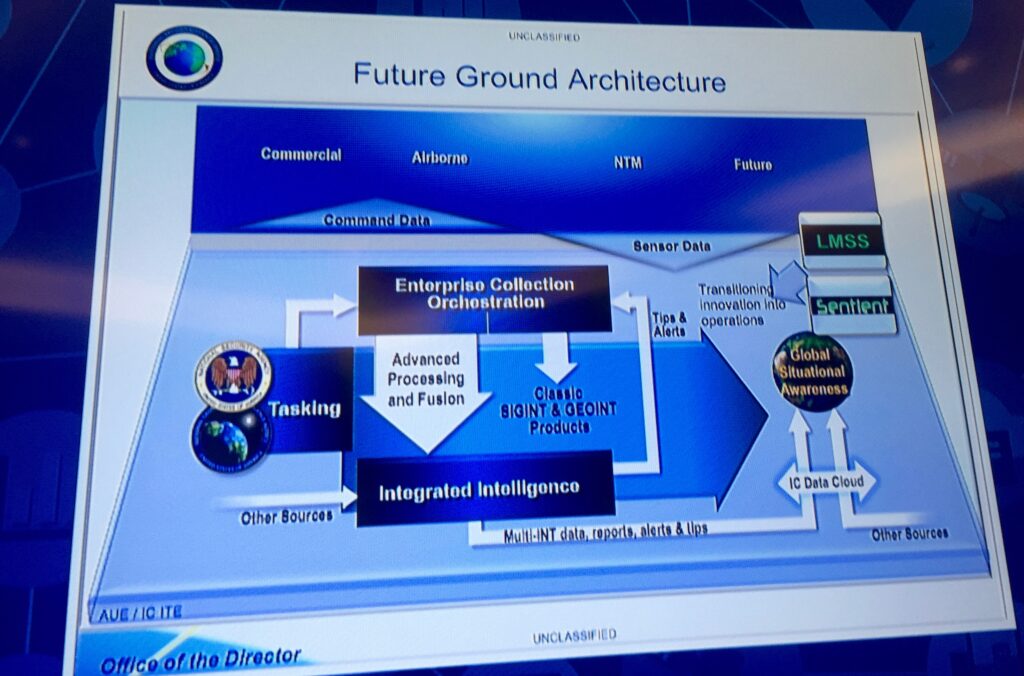NRO Tries New Automatic Systems That Analyze Data & Move Satellites
Posted on

Betty Sapp, NRO Director, GEOINT 2016
UPDATED: NRO Confirms SpaceX Launch Buy
GEOINT: The Pentagon’s Third Offset strategy puts much faith in artificial intelligence and machine-to-machine communications. The National Reconnaissance Office is already working on making those a reality, deploying prototypes of its new next-generation ground systems, Director Betty Sapp said here this morning.
“We anticipate fielding a ground system able to direct appropriate multi-int collection assets against intelligence problem observables able to redirect assets for digital collection to improve our knowledge and able to learn and adapt, all before any human sees what’s happening,” Sapp said. Her address to the GEOINT conference is one of the rare times she actually speaks before the American public each year, despite a strong push by Director of National Intelligence Jim Clapper for greater transparency on the part of the Intelligence Community.
Sapp said “prototypes are driving operations today” that “move at machine speed to notice the unusual hidden among the host of the unusual.” She appeared to identify one of the prototypes when she said the “Sentient” prototype was involved. Our attempts to get more details from NRO public affairs were, as usual, fruitless.

Chart presented by DNRO Sapp at GEOINT 2016
But it’s clear this is all part of a massive NRO effort to build a new “Future Ground Architecture” able to control all the NRO’s satellites, accept data from them all and distribute that data quickly and effectively. The last system, known as Mission Integration and Development (MIND), marked a rare high point in the acquisition of satellite ground control systems. The Raytheon equipment came in one time and on budget.
This ground system will be especially important because Sapp made clear the NRO — famous for building huge satellites (often school-bus big) that boast “exquisite” capabilities — is buying cubesats and is using them “for actual mission application.” My colleague Mike Gruss at Space News reported that NRO has launched 15 cubesats in recent years. This is doubtless part of the general push to make US space systems more “resilient” in the face of growing threats to satellites from Russia and China.
Sapp mentioned those threats in her speech, but provided no new details about either the extent or the nature of those threats. She did, however, make clear that the US could now handle those threats. “I think we were slow to recognize and change. I think we’ve been very good at catching up,” she said, adding that “we will be survivable.” She said the NRO will start measuring that resilience next year, which appears to mean they will establish a baseline.
Sapp also mentioned that the NRO has bought launches from SpaceX, appearing to indicate that this was new. I was unable to confirm whether that is accurate or not. UPDATE BEGINS: My colleague Mike Gruss at Space News got a rare reply from the NRO, confirming a previously unannounced purchase.
“SpaceX is scheduled to launch a payload for the National Reconnaissance Office in March 2017 from Cape Canaveral Air Force Station in Florida, a spokeswoman for the intelligence agency said May 18 in response to questions from SpaceNews.
“SpaceX has not announced the launch. The NRO, which builds and operates the nation’s spy satellites, is thought to have previously mentioned the contract in a public setting just once, during a congressional hearing three years ago.
“The March 2017 mission is known as NROL-76, but further details about the launch, including which rocket SpaceX would use to lift the satellite, the cost of the launch, or whether the mission was competitively bid were not immediately available, an NRO spokeswoman said.”
Glad to see the NRO replying sometimes. UPDATE ENDS
Subscribe to our newsletter
Promotions, new products and sales. Directly to your inbox.
